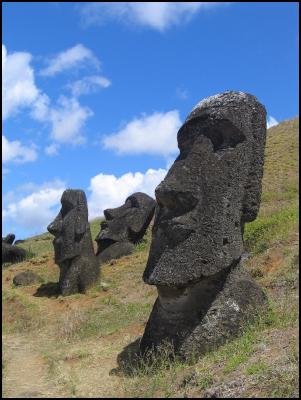Scientists To Probe Demise Of Easter Islanders
Scientists To Probe Mysterious Demise Of Easter Islanders

MEDIA RELEASE from GNS
Science
25 September 2008
Scientists To
Probe Mysterious Demise Of Easter Islanders
A New Zealand-led group of scientists plans to use sophisticated analytical techniques to try and solve the mystery of the sudden collapse of the population on Easter Island in pre-European times.
The group, led by environmental scientist Troy Baisden of GNS Science and plant ecologist Mark Horrocks of Microfossil Research Ltd, wants to test a hypothesis that the Easter Island population over-shot the carrying capacity of their aged and weathered volcanic soils.
If the same situation occurred today, Dr Baisden says the population would either migrate from the island or top dress with industrial fertilisers. But the Polynesian inhabitants didn’t have that luxury and paid a heavy price.
Dr Baisden and his colleagues have won funding of $770,000 over three years from the Marsden Fund to undertake the project.
The project is entitled ‘Was collapse inevitable on Easter Island (Rapa Nui)? Reconstructing a civilisation’s failure.’
Often, the most valuable possession of ancient civilisations was their soil, Dr Baisden says.
“Easter Island developed a remarkable agricultural civilisation that was capable of erecting stone statues weighing up to 80 tonnes each.”
“However, while the clans on Easter Island were competing to build the most impressive statues, we suspect their populations overshot the carrying capacity of their fragile soils.”
Dr Baisden and his colleagues believe it is possible that soil nutrient depletion coincided with the Island’s population reaching a maximum.
The group is proposing a range of scientific techniques to reconstruct the “biogeochemistry” of collapse to see if it occurred at the same time as soil nutrient depletion.
In craters where settlement occurred, the scientists will collect about a dozen sediment cores for analysis in New Zealand. The aim is to precisely determine the timing of changes in plant, animal, and human populations, as well as soil fertility.
They will examine plant microfossils such as pollen and starch grains, nitrogen isotopes, the DNA of native forest species, and steroid biomarkers from humans, animals, and plants.
Working with Drs Baisden and Horrocks on this project is Emeritus Professor John Flenley of Massey University, as well as US and Australian collaborators.
Dr Baisden says he developed the project because he was inspired by the 2005 best-selling book Collapse: How Societies Choose to Fail or Succeed, by Californian academic Jared Diamond.
“We want to know if Easter Island’s collapse holds lessons for modern society. If the Easter Islanders overshot the carrying capacity of their soils, there’s a strong parallel to the current financial crisis, in which Wall Street overestimated the returns from the housing market.”
ENDS


 Science Media Centre: What Goes Into Making Our Seasonal Flu Jab? – Expert Q+A
Science Media Centre: What Goes Into Making Our Seasonal Flu Jab? – Expert Q+A The Document Foundation: Celebrating 20 Years Of The OASIS Open Document Format (ODF) Standard
The Document Foundation: Celebrating 20 Years Of The OASIS Open Document Format (ODF) Standard Maritime Union of New Zealand: Maritime Union Raises Serious Concerns Over Aratere Ferry Removal
Maritime Union of New Zealand: Maritime Union Raises Serious Concerns Over Aratere Ferry Removal Ferry Holdings Limited: Decommissioning Of The Aratere Ferry
Ferry Holdings Limited: Decommissioning Of The Aratere Ferry Broadcasting Standards Authority: Inaccurate 1News Reporting On Football Violence Breached Broadcasting Standards
Broadcasting Standards Authority: Inaccurate 1News Reporting On Football Violence Breached Broadcasting Standards Better Taxes for a Better Future: $1b Cut In Budget Operating Allowance ‘Unnecessary And Damaging’
Better Taxes for a Better Future: $1b Cut In Budget Operating Allowance ‘Unnecessary And Damaging’